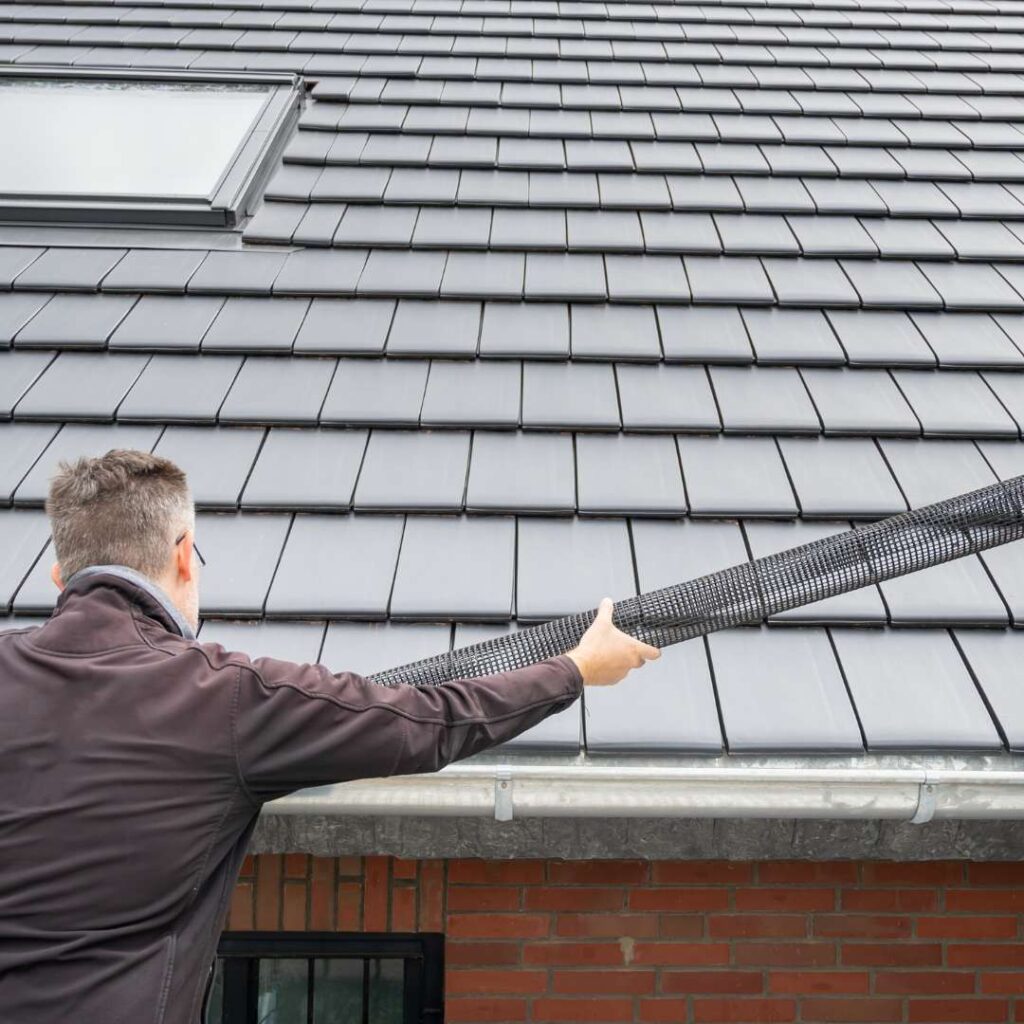Every homeowner knows the importance of maintaining their property, but one area often overlooked is the humble gutter. Gutter maintenance might not be at the top of your weekend to-do list, but neglecting it can lead to costly repairs.
This is where gutter guards come into play. Designed to keep debris out while allowing water to flow freely, gutter guards are an investment that can save you time and money. In this blog post, we’ll explore everything you need to know about gutter guards—from how they work to the different types available—and why they might be the perfect solution for your home.
What Are Gutter Guards and Why Do You Need Them?
Gutter guards are covers that cover your gutters to prevent debris like leaves and twigs from clogging them. While the concept is simple, the benefits are numerous. First, they reduce the frequency of gutter cleaning, a task few enjoy but everyone needs to do. Secondly, by preventing clogs, they reduce the risk of water damage to your home, which can be a homeowner’s nightmare. Finally, they can help extend the life of your gutters, making them a cost-effective solution in the long run.
In addition to these practical benefits, gutter guards offer peace of mind. Imagine sitting inside on a rainy day, knowing your gutters are functioning perfectly without your intervention. This level of convenience and security makes gutter guards so appealing to homeowners.
How Gutter Guards Work
Understanding how gutter guards work can help you appreciate their value. Essentially, these guards act as a barrier over your gutters. They have tiny holes or slits that allow water to enter while blocking larger debris. This design ensures water flows smoothly through gutters and downspouts, preventing overflow and potential water damage.
Different types of gutter guards employ various mechanisms for keeping out debris. Some use a mesh material, while others use foam or brush-like bristles. Despite these differences, the end goal remains the same: keeping your gutters clear of debris so they can function efficiently. The effectiveness of gutter guards often depends on your chosen type, which we’ll explore in the next section.
Types of Gutter Guards You Can Choose
When choosing gutter guards, you have several options, each with pros and cons. The most common types include mesh screens, reverse curve guards, bottle brushes, nylon guards, and foam inserts. Mesh screens are famous for their simplicity and effectiveness, while reverse curve guards direct water downward into the gutter, forcing leaves to fall to the ground.
Bottlebrush guards sit inside the gutter and catch debris while allowing water to flow. Nylon guards are handy in colder climates as they prevent snow and ice buildup. Foam inserts block debris from entering the gutter, though they may require more frequent maintenance. Each type has unique features, so it’s essential to consider your specific needs and environment when choosing.
Benefits of Installing Gutter Guards
The benefits of installing gutter guards go beyond just protecting your gutters from debris. One of the most significant advantages is the reduced maintenance required. Without guards, gutters must be cleaned regularly to prevent clogs. With guards, you can reduce cleaning frequency, saving time and effort.
Additionally, gutter guards help protect your home from water damage. Overflowing gutters can lead to water seeping into your foundation, causing structural issues. By keeping gutters clear, guards help ensure proper drainage and prevent such costly damages.
Finally, gutter guards can enhance your home’s curb appeal. Clean, well-maintained gutters contribute positively to a home’s aesthetics, and guards can help you achieve that effortlessly. They offer a blend of functionality and style, making them a valuable addition to any home.
Potential Drawbacks to Consider
While gutter guards offer numerous benefits, it’s essential to consider potential drawbacks. First, the initial installation cost can be significant, depending on the type you choose and the size of your home. However, this cost is often offset by savings in maintenance and potential repair costs.
Another consideration is that gutter guards are not entirely maintenance-free. While they reduce the frequency of cleaning, they still require occasional checks to ensure they’re functioning correctly. Debris may accumulate on top of the guards, necessitating removal to maintain optimal performance.
Finally, not all gutter guards are created equal. Some may not perform well in heavy rain or snowy conditions, leading to potential issues. Choosing a guard that suits your specific climate and needs is crucial to avoid any performance problems.
How to Install Gutter Guards
Installing gutter guards can be straightforward, but it often depends on the type of guard and your existing gutter system. Some guards are easy to install as a DIY project, while others may require professional installation to ensure proper fit and function.
Before installing, it is vital to clean your gutters thoroughly to remove any existing debris. This step ensures that the guards can perform optimally from the start. Follow the manufacturer’s instructions carefully and ensure the guards are securely fastened to prevent them from coming loose in harsh weather conditions.
If you’re unsure about installing the guards, consider hiring a professional. They can ensure a seamless installation, providing peace of mind that your gutters are well-protected.
Maintenance Tips for Gutter Guards
While gutter guards reduce the frequency of gutter cleaning, some maintenance is still required to keep them in top shape. Regularly inspect your gutter guards to check for any accumulated debris. Depending on the type of guard, you may need to brush off leaves or remove any trapped dirt.
Monitoring your gutters during heavy rain is essential to ensure the guards function correctly. If you notice any overflow or water pooling, it may indicate a blockage that needs addressing.
Finally, consider scheduling a professional inspection every few years to ensure your gutter system, including the guards, is in optimal condition. This proactive approach can prevent minor issues from becoming major problems.

Cost Considerations for Gutter Guards
The cost of gutter guards varies based on the type, material, and installation method. DIY options like mesh screens are generally more affordable, while professionally installed systems like reverse curve guards can be more expensive.
When considering the cost, consider the long-term savings in maintenance and potential repair costs. Gutter guards can extend the life of your gutters and protect your home from water damage, making them a cost-effective investment.
Remember that higher-priced options often offer better performance and durability, so balance your budget with your needs and climate conditions.
Gutter Guards and Climate Considerations
Your local climate plays a significant role in determining the type of gutter guard that is best for your home. In areas with heavy rainfall, choose guards with larger holes to accommodate increased water flow. Opt for guards that prevent ice dams and snow buildup in colder climates, such as nylon guards.
Consider the type of trees around your home when choosing gutter guards. If you have pine trees that shed small needles, choose a guard with a fine mesh to prevent debris from entering the gutters. Tailor your choice to your environment to ensure optimal performance.
How Gutter Guards Impact Home Value
Installing gutter guards can positively impact your home’s value by enhancing its overall appearance and reducing maintenance needs. Potential buyers appreciate homes with features that simplify upkeep, and gutter guards are seen as a valuable addition.
Additionally, gutter guards protect your home from potential water damage, which can be a significant selling point. By preserving your home’s structural integrity, gutter guards contribute to long-term value and appeal.
Consider gutter guards an investment in your home’s future, offering practical benefits and increased marketability.
Common Myths About Gutter Guards
Several myths surround gutter guards, leading to misconceptions about their effectiveness. One common misconception is that gutter guards eliminate the need for cleaning entirely. While they reduce cleaning frequency, some maintenance is required to ensure optimal performance.
Another myth is that gutter guards don’t work in heavy rain or snowy conditions. While some guards may struggle in certain climates, choosing the right type for your environment can effectively address these concerns.
Lastly, some believe gutter guards are too expensive to justify the investment. However, when considering the long-term savings in maintenance and potential repair costs, gutter guards are often cost-effective.
Conclusion
In conclusion, gutter guards are a wise investment for homeowners seeking to protect their gutters and homes from potential damage. By reducing maintenance needs, preventing clogs, and enhancing curb appeal, gutter guards offer numerous benefits. While considering factors like cost, maintenance, and climate, it’s clear that the advantages far outweigh any drawbacks. For those ready to take the next step, consult a professional to find the best gutter guard solution for your home. Your future self will thank you for the peace of mind and protection they provide.
You may also like to take a look at some of these great resources: Also, here are some resources to help you select a reputable contractor:



